#jacques deforest
Explore tagged Tumblr posts
Text
Jacques Deforest: A Miraculous Ladybug OC
Name: Jacques Deforest
Age: late 40′s
Physical description: 5′10″ tall, broad-shouldered, physically fit, short, dark brown hair, clean shaven with a scar across his face
Wardrobe: Dark green t-shirt, black leather biker jacket, blue jeans, black leather boots, and occasional black sunglasses
Story: Jacques Deforest has always been on the wrong side of the tracks. Coming from a problematic home and with a younger sister and brother, Jacques learned to fend for himself, and them, at an early age. Sadly, while his siblings managed to get on the right track, Jacques found himself addicted to the thrill of being on the wrong track. He soon became a criminal, and would eventually create his own gang, a “pack” if you will, of whom he is the “alpha.” Jacques and his gang now terrorize the locals wherever they go. However, ruthless and cruel as he may seem, deep down, Jacques still has a small sense of honor and loyalty to those he cares about. Who knows? One day, at the very least, he might do the wrong thing for the right reason.
#miraculous#miraculous ladybug fanfiction#original character#jacques deforest#marinette dupain cheng#adrien agreste#alya cesaire#nino lahiffe#chloe bourgeois#sabrina raincomprix#rose lavillant#juleka couffaine#nathaniel kurtzberg#alix kubdel#le chien kim#max kante#ivan bruel#lila rossi#luka couffaine#kagami tsurugi#tom dupain#sabine cheng#gabriel agreste#emilie agreste#nathalie sancoeur#andre bourgeois#audrey bourgeois
8 notes
·
View notes
Text

Jacques Deforest & Anton Moreau from Stammering Adrien AU by @awholelotofladybug!
I want to clarify that I don’t draw humans often so I draw them as animals instead.
Jacques is a Grey Wolf. Anton is a King Cobra. (It’s little hard to see the hood.
Also! Anton’s arms are cybernetic because snakes have no limbs so they got cybernetic arms.

(No shadings)

(No backgrounds)
#ibispaint art#miraculous ladybug#MLB Animalverse#anton moreau#jacques deforest#stammering adrien au#grey wolf#king cobra#cybernetics#cybernetic arms
4 notes
·
View notes
Text
Tell me which ship that includes my Rebecca Simpson OC, you want to see my best art of.
1. Sideshow Bob X Rebecca
2. Krusty X Rebecca
3. Milhouse X Rebecca
4. Moe X Rebecca
5. Mr. Burns X Rebecca
6. Principal Skinner X Rebecca
7. Sean Bont X Rebecca
8. Apu X Rebecca
9. Barney X Rebecca
10. Blake Black X Rebecca
11. Bode Wright X Rebecca
12. Chief Wiggum X Rebecca
13. Colin X Rebecca
14. Jack DeForest X Rebecca
15. Frank Grimes X Rebecca
16. Superintendent Chalmers X Rebecca
17. Ol' Gil X Rebecca
18. Hank Scorpio X Rebecca
19. Hubert Wong X Rebecca
20. Ralph X Rebecca
21. Jacques Brunswick X Rebecca
22. Jimbo X Rebecca
23. Professor Frink X Rebecca
24. Julio Franco X Rebecca
25. Karl (Simpson and Delilah) X Rebecca
26. Lenny X Rebecca
27. Luke Stetson X Rebecca
28. Sideshow Mel X Rebecca
29. Ned Flanders X Rebecca
30. Nelson X Rebecca
31. Brenden Biederbecke X Rebecca
32. Nick (the Daughter Also Rises) X Rebecca
33. Stonecutter Number One X Rebecca
34. Otto X Rebecca
35. Grady X Rebecca
36. Lucas Porter X Rebecca
37. Snake Jailbird X Rebecca
38. Thelonious (Trilogy of Error) X Rebecca
39. Troy McClure X Rebecca
40. Freddie Scorpio X Rebecca
41. Lionel Hutz X Rebecca
42. Hugh Parkfield X Rebecca
43. Dr. Nick X Rebecca
44. Cecil Terwilliger X Rebecca
45. Fat Tony X Rebecca
46. Edmund (Tweenlight) X Rebecca
47. Reverend Lovejoy X Rebecca
48. Todd Flanders X Rebecca
49. Walt Warren (the Bob Next Door) X Rebecca
50. Willie X Rebecca
51. Bart X Rebecca
52. Herbert Powell X Rebecca
53. Homer X Rebecca
54. Jack Lassen X Rebecca
55. Artie Ziff X Rebecca
56. Jack Crowley X Rebecca
57. Dwight Diddlehopper X Rebecca
58. Mr. Bergstrom X Rebecca
59. Freddy Quimby X Rebecca
60. Comic Book Guy X Rebecca
61. Bleeding Gums Murphy X Rebecca
62. Cletus Spuckler X Rebecca
63. Disco Stu X Rebecca
64. Larry Burns X Rebecca
65. Officer Eddie X Rebecca
66. Hans Moleman X Rebecca
67. Mayor Quimby X Rebecca
68. Michael D'Amico X Rebecca
69. Bartigula the Jerk (I, Carambus) X Rebecca
70. Dr. Marvin Monroe X Rebecca
71. Wayne Slater (The Falcon and the D'ohman) X Rebecca
72. Billie Joe Armstrong (Green Day) (The Simpsons Movie) X Rebecca
73. Kent Brockman X Rebecca
74. Carl Carlson X Rebecca
75. Langdon Alger (Simpsons Comics) X Rebecca
76. Charlie (Oh Brother, Where Bart Thou?) X Rebecca
77. Portuguese Boy (A Totally Fun Thing Bart Will Never Do Again) X Rebecca
78. Peta (Dry Hard) X Rebecca
79. Pita (Dry Hard) X Rebecca
80. Martin Prince X Rebecca
81. Kirk Van Houten X Rebecca
82. Blake (Three Dreams Denied) X Rebecca
83. Corey Masterson X Rebecca
84. Dolph X Rebecca
85. Donny (The deBarted) X Rebecca
86. Digby Diggs (Diggs) X Rebecca
87. Kevin (Stealing First Base) X Rebecca
88. Zachary Vaughn (Bart Gets a Z) X Rebecca
89. The Rich Texan/Richard Texan X Rebecca
90. Rainier Wolfcastle X Rebecca
91. Marv Szyslak X Rebecca
92. Michael De Graaf X Rebecca
93. August Steffan X Rebecca
94. Homer Simpson (Not It) X Rebecca
95. Erik X Rebecca
96. Moe Szyslak (Not It) X Rebecca
97. David (Treehouse of Horror XVI: Bartificial Intelligence) X Rebecca
98. Roger (Treehouse of Horror XXI: Master and Cadaver) X Rebecca
99. Hugo (Treehouse of Horror VII: The Thing and I) X Rebecca
100. Vampire Burns (Treehouse of Horror IV: Bart Simpson's Dracula) X Rebecca
101. John (Homer's Phobia) X Rebecca
102. Mike Wegman (Go Big or Go Homer) X Rebecca
103. Lyle Lanley (Marge vs. the Monorail) X Rebecca
104. Roger (Every Man's Dream) X Rebecca
105. Devil Flanders (Treehouse of Horror IV: The Devil and Homer Simpson) X Rebecca
106. Harry Potter (Treehouse of Horror XII: Wiz Kids) X Rebecca
107. The Fat in the Hat (Treehouse of Horror XXIV: The Fat in the Hat) X Rebecca
108. Reaper Homer (Treehouse of Horror XIV: Reaper Madness) X Rebecca
109. John Frink Sr. Robot (Treehouse of Horror XIV: Frinkenstein) X Rebecca
110. Mutant Burns (Treehouse of Horror VIII: Homega Man) X Rebecca
111. Hansel Bart (Treehouse of Horror XI: Scary Tales Can Come True) X Rebecca
112. Noir Homer (Treehouse of Horror XXXI: Into the Homerverse) X Rebecca
113. Dracula (Treehouse of Horror XX opening & Treehouse of Horror XXI: Tweenlight) X Rebecca
114. Stephen King (Treehouse of Horror XXIV opening) X Rebecca
115. Vampire Bart (Treehouse of Horror IV: Bart Simpson's Dracula) X Rebecca
116. Dr. Bartley (Treehouse of Horror XV: Four Beheadings and a Funeral) X Rebecca
16 notes
·
View notes
Text
In his often prickly homage to the city of his birth, San Juan, ciudad sonada (2005; San Juan: Memoir of a City), Puerto Rican novelist Edgardo Rodriguez Julia writes about the rapid and often devastating changes in the island’s rural and urban landscape brought about by the shift from an agrarian to a manufacturing and tourism economy ushered by the Estado Libre Asociado (the Commonwealth) in the 1950s. “Todo el paisaje de mi infancia ha desaparecido” (All the landscapes of my childhood have disappeared), he writes, lamenting the loss of once-familiar landscapes to make way for high-rise office buildings [...], tourist hotels and casinos. He mourns the disappearance of the old road from Aguas Buenas to Caguas, “una de las mas hermosas del pais, con sombra de pueblo a pueblo a causa de su tupido dosel de flamboyanes y jacarandas” (one of the most beautiful on the island, shadowed from one tow to the other by a dense canopy of flame trees and jacarandas) before concluding that “la herida en mi paisaje infantil estremece” (the wound on my childhood’s landscape sends shivers down my spine).
Rodriguez Julia’s elegy to this old vanished road, which I remember for the lace-like patterns created on the hot tarmac by the sunlight filtering through leafy trees and the bright-red flowers of the flamboyant tree, reminds us of how, in the Caribbean region, profound and often vertiginous changes ushered by a variety of post 1950s historical events -- the collapse of the sugar industry, the shift from agrarian to tourism economies, urbanization and industrialization, deforestation and desertification -- have turned Antillean geographies into unrecognizable landscapes [...]. The rapid deterioration of the environment of the Caribbean region, which has taken place within the lifetime of many of its residents, has led to a “sense of an ending,” to the apocalyptic dread of a potential ecological disaster that can erase the islands [...] from the geographies of the mare nostrum. This fear underpins the development of a Caribbean environmentalist philosophy that is inextricably tied to a critique of [...] the latest manifestation[s] of rampant capitalism in whose grip the islands have remained since the Columbian encounter. [...]
-------
The literature of Haiti has bemoaned the environmental calamity that has befallen its people, denounced the practices that led to this catastrophe, and offered inspiration [...]. It has counseled, above all, political action against exploitative governments as a path towards environmental safety, focusing on the state’s inaction as evidence of the slow violence of environmental neglect. From Jaccques Roumain’s Gouverneurs de la rosee (1944; Masters of the Dew), a seminal text in the development of the Haitian novel, to Pierre Clitandre’s Cathedrale du mois d’aout (1979; The Cathedral of the August Heat), the Haitian novel has been, above all, a chronicle of the nation’s unimaginable ecological catastrophe. [...] Jacques-Stephen Alexis in Les Arbres musiciens (1957; The Musician Trees), speaks of the trees of Haiti’s embattled forests “as a great pipe organ that modulates with a multiple voice ... each with its own timbre, each pine a pipe of this extraordinary instrument,” hoping to endow them with a mythical protection [...]. Marie Chauvet, in Amour (from Amour, Colere et Folie, 1968; Love, Anger, Madness: A Haitian Trilogy), dissects the forces that led to the ecological revolution produced by deforestation [...], especially during the nineteen years of American Occupation, which lasted from 1915 to 1934. Clitandre chronicles the misery and hope of an exploited peasantry seen as one more cheap commodity to exploit locally or export [...].
Despite decades of literary denunciation, the Haitian landscape has continued its rapid decline, proving, in the process, that in Haiti, as “throughout the world, environmental hazards have been unequally distributed, with poor people and people of color [the formerly colonized] bearing a greater share of the burden [...].” Because the Caribbean shares Haiti’s history of colonial exploitation [...], the ghost of Haiti haunts the Caribbean imaginary. Its ecological disintegration has become [a] focal point for meditations on the region’s environmental options. It is not surprising, then, that as events have proven convincingly to the world that Haiti’s ills could not be cured through foreign aid, investment, or technology -- that it would take more than [...] a change in leadership [...] -- we have witnessed growing levels of popular engagement with local environmental movements elsewhere in the Caribbean [...].
-------
Habitat loss was the most radical impact of rapid urbanization in San Juan’s metropolitan area [...]. Corretjer’s beloved “greenblack highlands,” especially the lands through which flows the Encantado River with its grand cascades and crystalline pools [...] had been severely deforested to allow for the intensive cultivation of coffee. Land and water had been contaminated by insecticides and fertilizers. [...] Now [...], the lands have been planted [...] with numerous native species -- citrus trees, teak, cedar, royal palms, star apples, guava and guamo trees. [...] “The singing bees are already back [...]. [W]e can hear the mucaros [screech owls] at night.” [...] The defense of these spaces as “sacred” [...] endows them with special significance when they are threatened by development, as was the case in St. Lucia when the Hilton chain was given permission by the state to build the Hilton Jalousie Plantation Resort in the valley sloping down to the sea between the Pitons, the two great volcanic cones on the west coast of St. Lucia -- “one of the great landscapes of the Caribbean” [...]. St. Lucian poet [...] Derek Walcott joined in vocal opposition to the project on the grounds that The Pitons was undeniably a natural space [...] where a hotel would be “aesthetically like a wound.” [...] [H]e explained [...] his perception of the Pitons as a “sacred space” [...] that emanates power. [...]
[T]he Jalousie resort [...] opened in 1994 [...].
-------
All text above by: Lizabeth Paravisini-Gebert. “Caribbean Utopias and Dystopias: The Emergence of the Environmental Writer and Artist.” In: The Natural World in Latin American Literatures: Ecocritical Essays on Twentieth Century Writings. 2010. [Some paragraph breaks/contractions added by me. Presented here for commentary, teaching, criticism.]
38 notes
·
View notes
Text
Photo Essay Final Draft

The Ellie Schiller Homosassa Springs Wildlife State Park is located at 9350 W Fishbowl Dr, Homosassa, FL 34448. Their hours of operation are from 9-5:30 pm Monday through Sunday. Cost of admission is $13 for an adult ticket. Children under five years of age have free admission.

The Ellie Schiller Homosassa Springs Wildlife State Park’s most prominent and popular attraction is the Wildlife Walk, there are two initial paths to take. One on the left and one on the right. This walk is a path that goes around the entirety of the park and gives park-goers an opportunity to experience the animals in their natural habitats, as well as an opportunity to learn the names of the animals, and information about their species.

This park was originally founded as a sanctuary for Manatees in Florida that were bred in captivity, or injured in the wild. The park served as a Rehabilitation center founded by Marine Veterinarian Dr. Jesse Ray White in 1989. His work was featured in multiple documentaries. His case in rescuing a Manatee known as “Sewer Sam” was also covered by famous researcher Jacques Cousteau.

This park is located on the Homosassa River, and is one of the only places in Florida where people can see manatees in their natural habitat year round. The manatees here are well cared for and fed generously, as can be seen in the photo, the black square in the water is what's known as the manatee ‘Salad Bar’ , their feeding area. At the park, there is also a popular attraction in which viewers can go into a submerged viewing room, to see the Manatees swim underwater. Due to COVID-19, this attraction is currently closed. There are many water borne creatures that live here, such as river otters as well as a very popular hippopotamus.

This is Lu, a famous animal actor as well as the oldest hippo in the Americas. He is 61 years old and a crowd pleaser. Lu was transported to the park from San Diego where he was born to join the Ivan Tors Animal Actors. Lu has performed in numerous movies and television specials in nearly two decades and is now a beloved member of the Homosassa Community. So much so, that the people petitioned Florida Governor Lawton Chiles in 1989, to keep him in the park when the Florida Park Service planned to move him away. Lu is now famously a Florida Citizen recognized by the government and is allowed to stay in a Florida State Park as a non-native animal.

The birds in the park are eye-catchers to say the least. With their vibrant colors and varying shapes and sizes, there is always something new and exciting to see. Not only are there flamingos as far as the eye can see, but there are also other birds like red-tailed hawks, bald eagles and even pelicans. These flamingos are currently grooming themselves, after partaking in a morning breakfast.

The Homosassa Wildlife Park will always be home to species like this burrowing owl, who’s species once faced extinction due to deforestation. In this park the animals are more than just that, they are family. This is a place of great education and learning opportunities who’s purpose is to still teach people about wildlife and how to care for them. This park is a gem in the Homosassa community and will be for many years to come.
1 note
·
View note
Photo

Upcoming 2020 Exhibitions
We’re pleased to announce a selection of upcoming 2020 exhibitions. This winter, we welcome back our iconic Kehinde Wiley painting Napoleon Leading the Army over the Alps (2005), which for the first time at the Brooklyn Museum will be presented in dialogue with its early nineteenth-century source painting, Jacques-Louis David’s Bonaparte Crossing the Alps (1801). We also look at our collection from new perspectives with focused exhibitions that present historical works through a contemporary, multifaceted lens. Out of Place: A Feminist Look at the Collection examines nearly 50 collection works using an intersectional feminist framework. Climate in Crisis: Environmental Change in the Indigenous Americas is an installation of the Museum’s Arts of the Americas collection which reconsiders indigenous art from the perspective of the prolonged and ongoing impact of climate change and colonization. Contemporary artist and MacArthur Fellowship recipient Jeffrey Gibson mines our collection and archives to examine collecting practices and reinterpret historical representations of indigenous communities. We also present African Arts—Global Conversations, a cross-cultural exhibition pairing diverse African works with collection objects made around the world, and Striking Power: Iconoclasm in Ancient Egypt, which examines the damage to sculptures and reliefs in ancient Egypt as a way of also exploring twenty-first-century concerns and struggles over public monuments and the destruction of antiquities.
In March, we celebrate the iconic history and trailblazing aesthetics of Studio 54 in a special exhibition featuring never-before-seen archival materials, video, photography, fashion, and more. We will also present the first solo museum exhibition dedicated to Brooklyn-based photographer John Edmonds, winner of our inaugural UOVO Prize for an emerging Brooklyn artist. And in the fall of 2020, we are proud to mount the first career retrospective of the work of Lorraine O’Grady, one of the most significant figures in contemporary performance, conceptual, and feminist art.
“We’re thrilled to present a roster of exhibitions next season that are in conversation with our collection in fresh and exciting ways,” says Anne Pasternak, Shelby White and Leon Levy Director, Brooklyn Museum. “As an encyclopedic museum, we’re always looking for new ways to examine our collection and open it up to include narratives that have historically been left out of the canon. In 2020, we’re committed to exhibitions that do just that: telling stories that are rarely told, through the eyes of contemporary artists.”

Jacques-Louis David Meets Kehinde Wiley January 24–May 10, 2020 Morris A. and Meyer Schapiro Wing, 4th Floor
This exhibition brings an iconic painting from our collection—Kehinde Wiley’s Napoleon Leading the Army over the Alps (2005)—into dialogue with its early nineteenth-century source painting, Jacques-Louis David’s Bonaparte Crossing the Alps (1801). The two paintings, displayed together for the very first time, are on view in consecutive exhibitions at the Château de Malmaison from October 9, 2019, to January 6, 2020, and at the Brooklyn Museum from January 24 to May 10, 2020. This focused exhibition questions how ideas of race, masculinity, representation, power, heroics, and agency play out within the realm of portraiture. The presentation at the Brooklyn Museum is the first time David’s painting is on view in New York, and Wiley marks this momentous occasion by consulting on the exhibition design. It includes videos incorporating Wiley’s perspectives on how the Western canon, French portrait tradition, and legacies of colonialism influence his own practice. The exhibition represents an intimate conversation between two key artists of the nineteenth and twenty-first centuries and illuminates how images construct history, convey notions of power and leadership, and create icons.
The exhibition is organized by the Brooklyn Museum and Musée national des châteaux de Malmaison and Bois-Préau. The Brooklyn presentation is curated by Lisa Small, Senior Curator, European Art, and Eugenie Tsai, John and Barbara Vogelstein Senior Curator, Contemporary Art, Brooklyn Museum.

Out of Place: A Feminist Look at the Collection January 24–September 13, 2020 Elizabeth A. Sackler Center for Feminist Art, 4th Floor
This exhibition presents more than 50 works from across our collections. Following the 2018 exhibition Half the Picture: A Feminist Look at the Collection, Out of Place also explores collection works anew through an intersectional feminist framework. Out of Place features more than forty artists from remarkably different contexts whose unconventional materials and approaches call for a broader and more dynamic understanding of modern and contemporary art.
Examining how contexts change the way we see art, Out of Place: A Feminist Look at the Collection showcases artists who have traditionally been seen as “out of place” in most major collecting museums. The exhibition is organized around three distinct cultural contexts for making and understanding creativity—museums and art spaces, place-based practices, and the domestic sphere—and explores significant histories that have been, until recently, overlooked and undervalued, despite their influence outside of the mainstream. Out of Place traces how cultural institutions are challenged and changed by the ways artists work. Over half of the works in the exhibition are on view for the very first time, including important collection objects as well as significant new acquisitions, such as highlights from the recent Souls Grown Deep Foundation Gift of works by Black artists of the American South.
Artists featured include Louise Bourgeois, Beverly Buchanan, Chryssa, Thornton Dial, Helen Frankenthaler, Lourdes Grobet, Louise Nevelson, Dorothea Rockburne, Betye Saar, Miriam Schapiro, Judith Scott, Joan Snyder, and May Wilson, among others.
Out of Place: A Feminist Look at the Collection is curated by Catherine Morris, Senior Curator for the Elizabeth A. Sackler Center for Feminist Art, and Carmen Hermo, Associate Curator, Elizabeth A. Sackler Center for Feminist Art. Generous support for this exhibition is provided by the Helene Zucker Seeman Memorial Exhibition Fund.

Jeffrey Gibson: When Fire Is Applied to a Stone It Cracks February 14, 2020–January 10, 2021 Arts of the Americas Galleries, 5th Floor
This exhibition presents new and existing work by artist Jeffrey Gibson alongside a selection from our extensive collection and archives. Gibson collaborated with historian Christian Crouch to organize this exhibition that examines nineteenth- and early twentieth-century museum collecting practices, and the historical representations of indigenous communities, through a contemporary lens.
Gibson, an artist of Choctaw and Cherokee descent, often incorporates elements of Native American art and craft into his practice. He regards these aesthetic and material histories as modern, innovative, global, and hybrid. The presentation includes collection objects such as moccasins, headdresses, ceramics, and parfleche, and examples of beadwork and appliqué, displayed alongside Gibson’s contemporary works, which take material and formal inspiration from these traditional artistic practices. The exhibition also includes rarely exhibited items from our archives that shed light on the formation of the Brooklyn Museum’s Native American collection in the early twentieth century by curator Stewart Culin. The archival selections by Gibson and Crouch aim to return the focus to the indigenous individuals represented within the archives, recovering those individuals’ previously overlooked narratives and presence.
By presenting his own work alongside key selections from our collection, Gibson offers a different perspective on historical objects within a museum setting—one that is not static or stuck in the past, but ever evolving and modern. He encourages visitors to question long-held categorizations and representations of Native American art and challenges our understanding of tradition, practice, craftsmanship, and art-making.
Jeffrey Gibson: When Fire Is Applied to a Stone It Cracks is organized by Jeffrey Gibson and Christian Crouch, Curatorial Advisor, with Eugenie Tsai, John and Barbara Vogelstein Senior Curator, Contemporary Art, and Erika Umali, Mellon Curatorial Fellow, with support from Nancy Rosoff, Andrew W. Mellon Senior Curator, Arts of the Americas, and Molly Seegers, Museum Archivist, Brooklyn Museum. Major support for this exhibition is provided by Ellen and William Taubman. Generous support is provided by the Brooklyn Museum’s Contemporary Art Committee, the FUNd, and Stephanie and Tim Ingrassia.
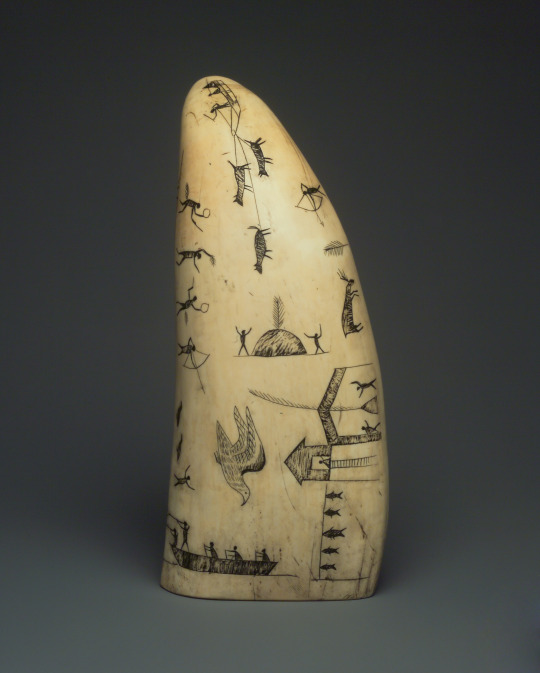
Climate in Crisis: Environmental Change in the Indigenous Americas February 14, 2020–January 10, 2021 Arts of the Americas Galleries, 5th Floor
Climate change is having a severe impact on indigenous communities across the Americas, but this situation has an even longer history. The European conquest and colonization of the Americas beginning in the sixteenth century introduced ways of using and exploiting natural resources that clashed with indigenous ways of understanding and relating to the natural world. This exhibition draws upon the strength of our renowned collection to highlight indigenous worldviews about the environment, and the ongoing threat of ecological destruction.
The installation includes work spanning 2,800 years, and explores how indigenous beliefs, practices, and ways of living are impacted by the climate crisis, ranging from the effects of melting sea ice and overfishing for Native peoples of the Arctic and Pacific Northwest to illegal logging and deforestation for indigenous communities in the Amazon. This environmental perspective reveals the fundamental disparities between the misuse of natural resources over the past five hundred years and indigenous communities’ profound relationships with their ancestral homelands. In addition, the exhibition incorporates voices of contemporary indigenous activists to underscore the work being done today to counter the climate crisis and protect the planet.
Climate in Crisis: Environmental Change in the Indigenous Americas is curated by Nancy Rosoff, Andrew W. Mellon Senior Curator, Arts of the Americas, with Joseph Shaikewitz and Shea Spiller, Curatorial Assistants, Arts of the Americas and Europe.

African Arts—Global Conversations February 14–November 15, 2020 Lobby Gallery, 1st Floor, and collection galleries on the 2nd, 3rd, and 5th Floors
African Arts—Global Conversations seeks to bring African arts into broader, deeper, and more meaningful and critical conversations about the ways that art history and encyclopedic museums have or have not included African artworks. It is the first exhibition of its kind to take a transcultural approach pairing diverse African works across mediums with objects made around the world―all drawn from our collection. It puts African and non-African arts from distinct places and time periods in dialogue with each other in an introductory gallery, as well as in “activation spaces” in the galleries dedicated to European Art, Arts of the Americas, American Art, Ancient Egyptian Art, and Arts of Asia. Duos, trios, and other groupings of objects from a wide variety of locations worldwide prompt conversations about history, art, race, power, design, and more. Approximately 33 artworks are presented (including 20 by African artists), as well as a selection of historical books. Highlights include the celebrated eighteenth-century sculpture of a Kuba ruler, a selection of fourteenth- to sixteenth-century Ethiopian Orthodox processional crosses, and a midtwentieth-century mask from Sierra Leone’s Ordehlay (Ode-Lay) society. Also on view are works by contemporary artists Atta Kwami, Ranti Bam, Magdalene Odundo OBE, and Taiye Idahor.
African Arts—Global Conversations is curated by Kristen Windmuller-Luna, Sills Family Consulting Curator, African Arts, Brooklyn Museum.

Studio 54: Night Magic March 13–July 5, 2020 Morris A. and Meyer Schapiro Wing and Iris and B. Gerald Cantor Gallery, 5th Floor
Studio 54: Night Magic is the first exhibition to trace the groundbreaking aesthetics and social politics of the historic nightclub, and its lasting influence on nightclub design, cinema, and fashion. Though it was open for only three years—from April 26, 1977, to February 2, 1980—Studio 54 was arguably the most iconic nightclub to emerge in the twentieth century. Set in a former opera house in Midtown Manhattan, with the stage innovatively re-envisioned as a dance floor, Studio 54 became a space of sexual, gender, and creative liberation, where every patron could feel like a star. From the moment Studio 54 opened, its cutting-edge décor and state-of-the-art sound and lighting systems set it apart from other clubs at the time, attracting artists, fashion designers, musicians, and celebrities whose visits were vividly chronicled by notable photographers. In addition to presenting the photography and media that brought Studio 54 to global fame, the exhibition conveys the excitement of Manhattan’s storied disco club with more than 600 objects ranging from fashion design, drawings, paintings, film, and music to décor and extensive archives.
Studio 54: Night Magic is curated and designed by Matthew Yokobosky, Senior Curator of Fashion and Material Culture, Brooklyn Museum. Lead sponsorship for this exhibition is provided by Spotify.

John Edmonds: A Sidelong Glance May 1, 2020–February 7, 2021 Stephanie and Tim Ingrassia Gallery of Contemporary Art, 4th Floor
John Edmonds is the first winner of the UOVO Prize, a new annual award for an emerging artist living or working in Brooklyn. This is Edmonds’s first solo museum exhibition and features approximately 25 new and recent photographic works that include portraiture and still lifes of Central and West African sculptures. Best known for his sensitive depictions of young Black men, Edmonds uses photography and video to create formal pictures that challenge art historical precedents and center Black queer desire. He often uses a large-format camera to heighten the staging of his subjects and explore their sculptural potential, making reference to religious paintings and modernist photography. Highlighting markers of Black self-fashioning and community— hoodies, du-rags, and more recently, African sculptures— Edmonds’s works point to individual style and a shared visual language across time.
John Edmonds: A Sidelong Glance is curated by Ashley James, former Assistant Curator, Contemporary Art, and Drew Sawyer, Phillip Leonian and Edith Rosenbaum Leonian Curator, Photography, Brooklyn Museum. Leadership support for the UOVO Prize is provided by UOVO.
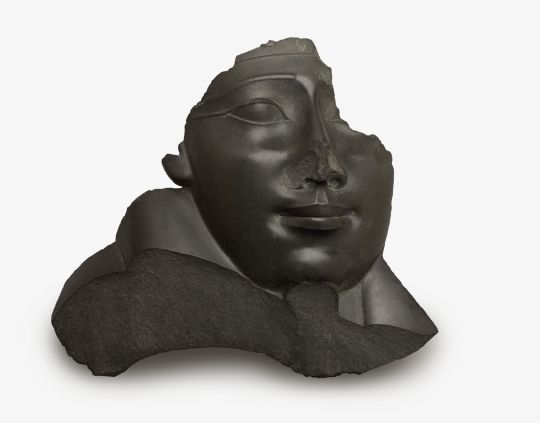
Striking Power: Iconoclasm in Ancient Egypt Opening May 22, 2020 Egyptian Galleries, 3rd Floor
This exhibition, which draws from our renowned Egyptian collection, seeks to establish a context for considering contemporary concerns and struggles over public monuments and damage to antiquities. Striking Power: Iconoclasm in Ancient Egypt explores patterns of organized campaigns of destruction to sculptures and reliefs motivated by shifting ideologies, politics, and crime in ancient Egypt, over a 2,500-year period. Presenting approximately 60 whole and damaged masterpieces of Egyptian art, the exhibition explores the damage that occurred during and after the rule of Pharaohs, with particular focus on the contested reigns of Hatshepsut (circa 1478–1458 B.C.E.) and Akhenaten (circa 1353–1336 B.C.E.). Targeted damage to sculptures typically occurred around a figure’s nose, which ancient Egyptians believed would remove the sculpture’s supernatural ability to breathe and therefore prevent the deceased figure from interacting with the human world. The exhibition explores the notion of public approval of iconoclasm and poses the question, who has the power to bring down or destroy images? Opinions about iconoclasm hinge on questions of whose narrative dominates public space. Many of the same questions about public art that concern the contemporary world, such as the role that U.S. Confederate monuments should play in today’s publically shared spaces, are illuminated through the lens of ancient iconoclasm.
Striking Power: Iconoclasm in Ancient Egypt is organized in collaboration with the Pulitzer Arts Foundation and is curated by Edward Bleiberg, Senior Curator of Egyptian, Classical, and Ancient Near Eastern Art, Brooklyn Museum.
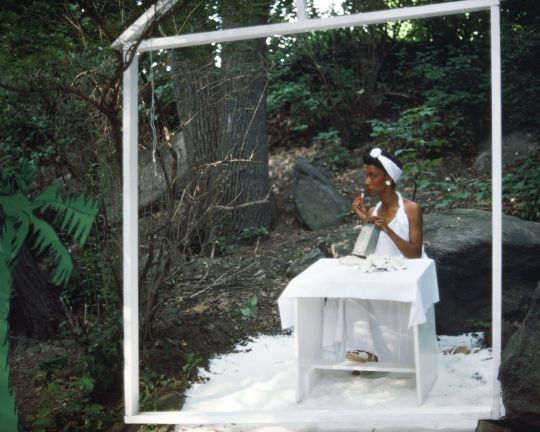
Lorraine O’Grady: Both/And November 20, 2020–April 11, 2021 Elizabeth A. Sackler Center for Feminist Art, 4th Floor
Lorraine O’Grady: Both/And is the first comprehensive retrospective of one of the most significant figures in contemporary performance, conceptual, and feminist art. For four decades, from the anger and hilarity of the early guerrilla performance Mademoiselle Bourgeoise Noire, to the joy and complexity of Art Is… on Harlem’s streets, to the haunting alternations in her single-channel video Landscape (Western Hemisphere), O’Grady has delved fearlessly into a range of timely questions: Black subjectivity (especially Black female subjectivity), diaspora, hybridity, art’s guiding concepts and institutions (from modernism to the museum), and the intersection of self and history. By putting contradictory ideas into play—black and white, self and other, here and there, West and non-West, past and present—and allowing them to interact with each other without expecting a concrete resolution, O’Grady’s work aims to replace the dualistic, “either/or” of Western thought with a productive, open-ended “both/and.” The urgency of the ideas she explores is perhaps the reason that her work is being newly embraced by a younger generation of artists who find much to learn from a practice that upends the fixed positions of power that structure our culture—while bringing into focus the poignancy of the lives that have been lived within these frameworks.
The exhibition includes twelve of the artist’s fourteen major projects, accompanied by a selection of material from her rich archive. It is accompanied by a catalogue documenting the full span of O’Grady’s artistic career, the first publication to do so, with essays by Malik Gaines, Harry Burke, Zoe Whitley, Catherine Morris, and Aruna D’Souza, along with a conversation between O’Grady and Catherine Lord.
Lorraine O’Grady: Both/And is organized by Catherine Morris, Senior Curator for the Elizabeth A. Sackler Center for Feminist Art, Brooklyn Museum, and writer Aruna D’Souza. Leadership support for this exhibition is provided by The Kaleta A. Doolin Foundation. Major support is provided by the Elizabeth A. Sackler Museum Educational Trust. Generous support is provided by Shelley Fox Aarons and Philip Aarons.
We hope to see you at the Museum soon!
Illustrated, from top:
Rose Hartman (American, born 1937). Bianca Jagger Celebrating her Birthday, Studio 54, 1977. Black and white photograph. Courtesy of the artist. © Rose Hartman
Kehinde Wiley (American, born 1977). Napoleon Leading the Army over the Alps, 2005. Oil on canvas. Brooklyn Museum, Partial gift of Suzi and Andrew Booke Cohen in memory of Ilene R. Booke and in honor of Arnold L. Lehman, Mary Smith Dorward Fund, and William K. Jacobs, Jr. Fund, 2015.53. © Kehinde Wiley. (Photo: Brooklyn Museum)
Lourdes Grobet (born Mexico City, Mexico, 1940). Untitled, from the series Painted Landscapes, circa 1982. Silver dye bleach photograph. Brooklyn Museum; Gift of Marcuse Pfeifer, 1990.119.12. © Maria de Lourdes Grobet. (Photo: Brooklyn Museum)
Jeffrey Gibson (American, born 1972). WHEN FIRE IS APPLIED TO A STONE IT CRACKS, 2019. Acrylic on canvas, glass beads and artificial sinew inset into custom wood frame. Courtesy of the artist and Kavi Gupta, Chicago. © Jeffrey Gibson. (Photo: John Lusis)
Eskimo artist. Engraved Whale Tooth, late 19th century. Sperm whale tooth, black ash or graphite, oil. Brooklyn Museum; Gift of Robert B. Woodward, 20.895. Creative Commons-BY. (Photo: Brooklyn Museum)
Kuba artist. Mask (Mwaash aMbooy), late 19th or early 20th century. Rawhide, paint, plant fibers, textile, cowrie shells, glass, wood, monkey pelt, feathers. Brooklyn Museum; Robert B. Woodward Memorial Fund, 22.1582. (Photo: Brooklyn Museum)
Guy Marineau (French, born 1947). Pat Cleveland on the dance floor during Halston's disco bash at Studio 54, 1977. (Photo: Guy Marineau / WWD / Shutterstock)
John Edmonds (American, born 1989). Two Spirits, 2019. Archival pigment photograph. Courtesy of the artist and Company, New York. © John Edmonds
Face and Shoulder from an Anthropoid Sarcophagus, 332–30 B.C.E. Black basalt. Brooklyn Museum; Charles Edwin Wilbour Fund, 37.1516E. (Photo: Brooklyn Museum)
Lorraine O'Grady (American, born 1934). Rivers, First Draft: The Woman in the White Kitchen tastes her coconut, 1982/2015. Digital chromogenic print from Kodachrome 35mm slides in 48 parts. Courtesy Alexander Gray Associates, New York. © Lorraine O’Grady/Artists Rights Society (ARS), New York
#brooklyn#studio54bkm#studio54#Kehinde Wiley#DavidxWiley#feminist art#jeffrey gibson#globalconversations#climate change#indigeneous art#native american#native american art#african arts#bkmafricanarts#john edmonds#bkmegyptianart#egyptian art#lorraine o'grady#brooklyn museum#museums#nyc#art#exhibitions
77 notes
·
View notes
Text

IN DEFENCE OF WHITE SOUTH AFRICA
Anyone who attended any of the recent public hearings on the SA government’s proposal to introduce legislation permitting land to be expropriated without compensation would have realised that there are two distinct trains of thought in this country, and never the twain will meet.
If ever the unbridgeable abyss between white and black thinking about land, a modern economy and food security was so starkly exposed, these sittings were it. Western logic was set against a strange mixture of racial resentment and at times open hatred, plus a thought process on the use of land which, if unconstrained, would lead to famine in SA.
As black after black speaker stated that whites were “rotten people”, that they “belonged to Europe and should go back”, that they took the land “because we were black”, that “we are impatient and we will take the land by force” and “these 1652 white gangsters robbed us”, whites in the audience simply shook their heads in hopelessness because who can argue with such obtuseness?
The futility of trying to debate with those who said they were “sick and tired of white people”, and that “whites won’t reconcile with us” was obvious. Whites were warned that “going to international courts” wouldn’t help because “the land will be taken physically”. One ANC provincial official declared that “since Jan van Riebeeck set foot on South Africa’s soil, whites have been rapists!”
The fact that the government used these public hearings as an endorsement of their own imbecility shows what South Africans are up against. Whether savvy urban blacks agree with the fatuous declarations by officials who clearly know nothing about how a modern economy works, or that scientific farming is the only path to food survival in a drought-ridden country like SA, is a moot point. Suffice it to say that anyone who thinks that the people in the halls will somehow uphold food security when they get “their land” needs to quickly go back to the drawing board.
MOMENT OF TRUTH
The moment of truth is upon us. We now must acknowledge that with the coming to power of the ANC, the stage was set for the inexorable destruction of, inter alia, South Africa’s food security. The government must be stopped in its tracks with this legislation. Amazingly there are still those who argue for “debate” and “compromise” on land expropriation (read theft). The immutable fact remains that only South Africa’s commercial farmers can produce enough food for 57 million people. No other group in the country can do this, and tinkering with this fact on the altar of political correctness or Freedom Charter humbug is setting South Africa on the road to Zimbabwe.
The unashamedly racist blacks spouting bile and venom against whites are clearly too backward to realise the bald irony of their situation – here they were hectoring the meeting chairmen about the evil whites in a hall built by whites, using a microphone not indigenous to Africa, wearing Western clothes, speaking a Western language, sending their children to schools teaching Western education, using Western money, buying food produced by white farmers, and travelling in Western transport. Virtually nothing inside or outside those halls, or in South Africa’s cities, towns and rural areas, is indigenous to Africa. Yet the people who created every single thing around them while they shouted and complained, were vilified. This strange anomaly has been commented upon with incredulity by several overseas TV presenters.
Not one jot of credit is ever given to white South Africa for taking most South African blacks out of the stone age. When the first Europeans arrived in South Africa in 1652, it was more than 1970 years after Ptolemy the First built the magnificent library at Alexandria in Egypt. In 1652 all that existed at the southern tip of Ptolemy’s continent were mostly warring tribes, living in mud and grass dwellings and using some decorated clay pots. Kraals held African wealth – cattle - while rudimentary crops were planted. Land did not “belong” to anyone in the Western sense of the word – it was just there, to be used. (It seems as if this mentality still exists - we want the land, is the clarion cry, with nary a thought about what will become of it (and them!) when it is “used up”.)
Living from day to day – the modus vivendi of Africa before Western influence – still exists in the minds of those now clamouring for land, otherwise they would be thinking of what they would do after taking the land. They haven’t the slightest idea, of course, and herein lies the danger, not within their minds but within the mind of the so-called sophisticated president of South Africa Cyril Ramaphosa. He is pandering to this lunacy for thirty pieces of voting silver in next year’s election. He’s also looking over his shoulder at the most backward of them all, Mr. Six Percent Julius Malema, he of the fiery but empty promises. The President is not telling his people the truth, and they will turn on him when they find out! And there will be no country south of South Africa to run to (as did the Zimbabweans) when the SA cupboard is bare!
In the meantime, the “land grab from the whites” clarion call rings loud and clear across the veld where no jobs exist, where the soil is degraded, and where nothing is produced. No wonder ignorant poor people are led to believe that a “piece of land” will improve their lot!
Ramaphosa’s blustering will not save South Africa. The despised whites will do so, with the other population groups. Whites are only 8.5% of the population (2011 Census) but without them there is Zimbabwe, there is Haiti. By 2030, based on SA’s current age 0 – 24 years population growth, there will be only one white for every 91 blacks. This is just over ten years hence!
GETTING RID OF THE WHITES
What will be the consequences of “getting rid of the whites”? Messrs. Ramaphosa and Malema would do well to read some history books. History is an unerring teacher. For those who never had the written word, they will need to consult the history of other nations. And history has shown us what happens when “getting rid of the whites” became a reality.
In 1804 a massacre occurred in the Caribbean country of Haiti, a French colony where slaves had already rounded upon their masters and slaughtered many whites during a revolutionary uprising some years before. Subsequent mass killings of whites were carried out on the order of one Jean-Jacques Dessalines, a mulatto. Full details of this relentless purge are in the history books, but suffice it to say that practically the whole French population of Haiti was annihilated.
Starting in the 1730’s, French engineers had constructed complex irrigation systems to increase sugar cane production in Haiti. By the 1740’s, Haiti and Jamaica (a British colony) had become the main suppliers of the world’s sugar. Haiti was the wealthiest colony in the New World. There existed tremendous racial friction and the slave revolt was certainly understandable. But the aim of relating this story is that once the whites were thrown out, Haiti never recovered. That is the point. The Caribbean nation of 10 million today cannot feed itself. More than a million families a day are fed by UN food aid. The country has had its share of natural disasters, often used as an excuse for its poverty. But Japan has more natural disasters per capita than any other nation, yet it is the world’s third largest economy.
Haiti is the poorest nation in the Western Hemisphere. The Duvalier family who ruled Haiti from 1957 to 1986 left the country economically decimated. Other corrupt and inept leaders followed. The hated colonists at least had created an economy, even though poverty existed. What followed the annihilation of the French was complete collapse. Ironically, educated professionals left Haiti for the lands of their former oppressors. Agriculture was destroyed, while deforestation and soil erosion worsened the impact of hurricanes and tropical storms.
ZIMBABWE
We don’t have to look further than across the river Limpopo to see what “getting rid of the whites” did to the once beautiful and productive land, Zimbabwe. The first white hunters, traders and missionaries who, in the 19th century came to the region, found a land devoid of infrastructure. The wheel was not in use. Early travellers moved around for days without seeing any human habitation. They recorded this fact. With a black population of about 250 000 at the time, most of the land was not occupied. (At the time of the Mugabe government purge of the whites in the 1980/1990’s, the black population stood at around 12 million.)
Commercial farming was started by white settlers on what was, for the most part, virgin land. There were no roads or railways, no electricity or telephones. There were no fences, boreholes, pumps, windmills, dams, irrigation schemes, cattle dips, barns or any other farm buildings.
From this barren starting point, commercial agriculture developed faster than it had anywhere else in the world, courtesy of the whites. Soon the country became self sufficient in most agricultural products. In many cases yields per hectare and quality equalled or bettered those in the developed world.
The United Nations Food and Agriculture Year Book of 1975 ranked the then Rhodesia second in the world in terms of yields of maize, wheat, soya beans and groundnuts, and third for cotton. In the combined ranking for all of these crops RHODESIA RANKED FIRST IN THE WORLD. Rhodesia’s Virginia tobacco was rated the best in the world in yield and quality. The world’s largest single citrus producer was developed early in the country’s history.
The story of the destruction of this productive country is that Western political correctness trumped good sense and the morality of being able to feed a population. Whites were literally chased out and murdered. Their farms were taken for “the people”, which farms mostly ended up in the hands of the governing party’s chums. Today it is estimated that more than three million black Zimbabwean refugees live on the fringes of South Africa’s cities.
In 1972 around 50 000 prosperous, hard-working Indians of Uganda were forced out of their own country by the puerile and mentally-retarded Idi Amin. His actions reveal the same inferiority complex now evident in the anti-white behaviour of SA’s rulers. They are patently unable to rule a country successfully. Instead of trying to learn, they destroy those who are successful. Do they care? Apparently not. In the early seventies, a top official of the Transkei homeland government told a visiting American that Transkeians didn’t care “if the roads turn to dust”, as long as they “got rid of the whites”. Well, the whites left and the roads did indeed turn to dust.
(It is noticeable that current Ugandan president Yoweri Museveni asked the Indians to return. Despite making up less than 1% of the population, Uganda’s Indians now contribute 65% of the country’s tax revenue).
Those meeting hall provocateurs who think milk comes in supermarket packets may be in for an unpleasant surprise. From SA’s 50 000 commercial dairy farmers in 1997, the figure is now a paltry 1600. Many could leave the industry in future. Will the new owners of these uncompensated farms continue to produce sufficient milk for the country? Mr. Ramaphosa should be thinking about this but of course he’s not. He’s worrying about holding on to power at the next election
SOUTH AFRICA BULLETIN
from the headquarters of
TAU SA in Pretoria
Web: www.tlu.co.za
4 notes
·
View notes
Photo

“Mankind has probably done more damage to the Earth in the 20th century than in all of previous human history.” – Jacques Yves Cousteau #political #politicalmeaning #aduarte7 #adlegacy #toinfinityandbeyond #savetheearth #climate #climatechange #zerowaste #ecofriendly #renewable #plasticocean #deforestation #savenature #savewildlife #noplastics #nopollution #waterpollution #savetheplanetearth #welovetheearth #savetheplanet🌍 #protectearth #environmentalprotection #followtrain #likeforlikeback #explorepage #curtidasporcurtidas #chuvadelikes100k #megachuva #tempestadedeseguidores — view on Instagram https://ift.tt/3gyMZwq
0 notes
Text
Friends in Bad Places 2: A Stammering Adrien AU Moment
Based on this AU.
Hawkmoth is furious when he finds out that his enemies have found a way to shield themselves, and others, from his akumas. He calls upon his cohorts to address the issue.
Hawkmoth: It is bad enough that I keep getting defeated by a bunch of children in playsuits. It’s bad enough that I lost the Peacock Miraculous and still can’t find that blasted Miracle Book. But this, THIS, is a slap in the face! Ladybug is somewhere LAUGHING AT ME! I might as well find her, and offer her the chance to SPIT IN MY EYE! *COUGH COUGH COUGH* *grabs his heart* AUGH!!
Deforest: Easy with the rage-fest. You’re gonna keel over
Moreau: *helps Hawkmoth up* You’re going at this the wrong way, Hawkmoth. It’s clear you can’t rely on random civilians with self-esteem issues. What you need is a ready supply of villains.
Hawkmoth: *clears his throat* Go on.
Deforest: We’ve gone where you haven’t, Hawk. And I can tell you right now, not everyone in Paris is thrilled about Ladybug.
Moreau: Indeed. And we know exactly where to find them.
Hawkmoth: *creates two akumas* Gentlemen, dawn your uniforms...
*Moreau and Deforest become Bogeyman and Pack Leader*
Hawkmoth: Time to draft our army.
*Later, in a seedy pub downtown filled with crooked, convicted criminals...*
*DOOR SWINGS OPEN*
*everyone looks towards the door*
Hawkmoth: Bonsoir, gentlemen!.
Pack Leader: *growl*
Bogeyman: *low, devious chuckle*
Hawkmoth: We’re looking for a few bad men...
#miraculous ladybug#hawkmoth#stammering adrien au#anton moreau(oc)#the bogeyman(oc)#pack leader(oc)#jacques deforest(oc)
12 notes
·
View notes
Text
Layers
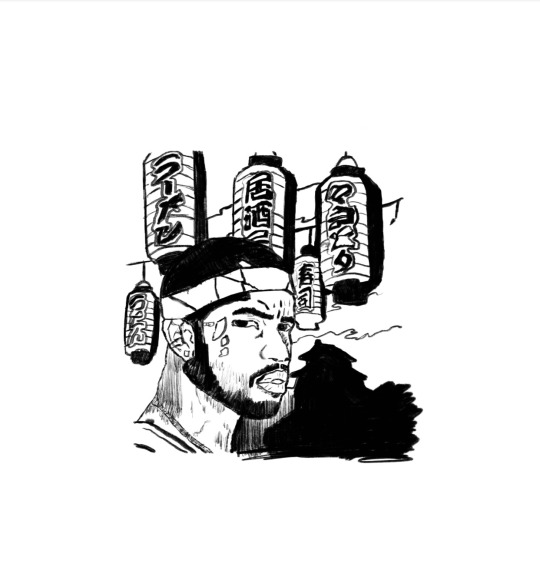
"Point, line, and plane are the building blocks of design." (Lupton 33) The point can be defined as a mark in a position of space. A line can be described as a single point that continues for a distance, or as the connection between two points. The purpose of a line in graphics is to help the artist to communicate to the viewers what it is they are supposed to be seeing or taking notice of. Layers can create a sense of depth in an image with point, line, and planes. Layers are the different levels at which one can place an image. Layers can be stacked, merged, or defined when creating a digital image. In this design, I used both point, line, and plane and layers as a way to create a nostalgic image. The person in the image is an African American singer and songwriter named is Frank Ocean. He is best known for his song “Thinking About You” on Channel Orange created in 2012. The reason I decided to draw him is his music speaks to me differently than anything I’ve heard before, you can say he is one of my favorite artist. I wanted my favorite artist to be in many favorite city, so I choose Mount Fuji in Japan.
Rhythm and Balance

In this design, I explored the power of perception or the ability to see, hear, or become aware of something through the senses. The words I choose to explore was the famous hashtag started by black Twitter “BLM’. BLM stands for “Black Lives Matters” which is a decentralized political and social movement advocating for non-violent civil disobedience in protest against incidents of police brutality and all racially motivated violence against black people. I wanted to emphasize the issue of Black lives to raise awareness of the death of innocent black bodies in America. I used a black woman as the face of this design to show the power of the black women’s role in the movement. Most of the time a black woman is defending herself and others on the front line. As Lupton said, “By exploiting the brain’s capacity to find and create order, designers construct simple, direct logos, layouts, and interfaces. In addition to seeking out clear, direct communication solutions, they can also use the processes of perception to invent surprising forms that challenge viewers to fill in the gaps.” (265) I wanted to challenge the viewer to fill in the gaps and think about why BLM is important to them by boldly presented the issue. I used eye contact as a way to manipulate perception as well.
Color
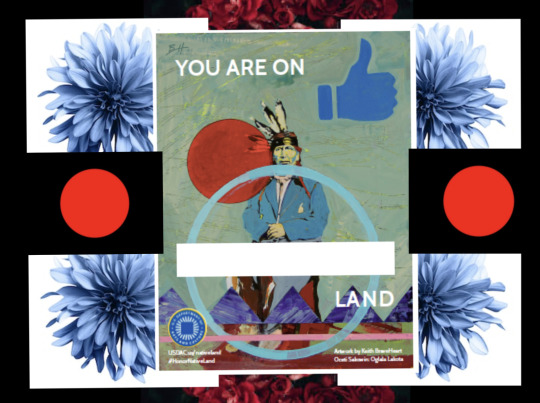
The perception of color depends on how the color is presented, the brightness, and the character of light. We can also perceive a given color in relation to the other colors. “Color can convey a mood, describe reality, or codify information. “Words like “gloomy,” “drab,” and “glittering” each bring to mind a general climate of colors, a palette of relationships. Designers use color to make some things stand out (warning signs) and to make other things disappear (camouflage).” (208) When creating the art based on Immigration and Native American land I thought about politics. During the election month, America seems to be divided into two. I wanted this design to bring awareness to the divide and create a central understanding. To create relationships between color and monotones I used the color red to emphasize the blood of millions of Native Americans and blue to express the beauty and pride that still exists. I used monotone green to create a feeling of warmness.
Boarders

A border is a design that runs lengthwise along the edge of a design.“Whether simple or decorative, a border creates a transition between image and background. Against the pale wall of a room, for example, a black picture frame sharply separates a work of art from its surroundings. Alternatively, a frame whose color is close to that of the wall blends the work of art with the room around it.” (Lupton 364) The purpose of my boarder was to emphasize my design of the Amur Leopards. These animals are one of the top ten animals to go extinct. The Amur leopard is threatened by poaching, habitat loss, and deforestation or of their land. Their natural habitat is also threatened by forest fires and the construction of new roads. I choose a black border to express boldness. I also juxtaposed the image to make a point that they're endangered.
Gestalt Principles
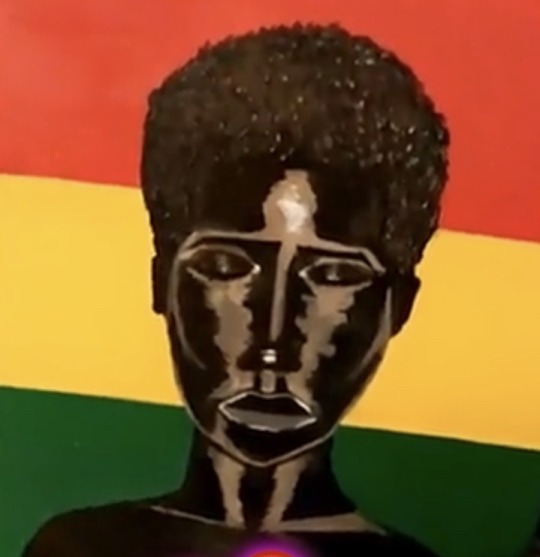
(5) Gestalt principals. Gestalt principles include similarity, continuation, closure, proximity, ground, symmetry, and order. “Building on memory and experience, the brain fills in gaps and filters out extraneous data.” (p. 99) Gestalt theory emphasizes that anything is greater than its parts. Gestalt principles can elevate a design that seems like it's fighting for a user's attention to one that offers a natural interaction that makes your design feel familiar while guiding users toward the action you want them to see. The goal of Gestalt’s theory is to teach people to become aware of sensations within themselves and their environment so that they respond reasonably to a situations. In this design, I used this Ghanises woman to communicate beautiful and pain. The interpretations could go in many directions but one thing you cant deny is the Ghanises flag behind her. In this flag, the star would normally be in the middle. However, she is the star. Her heart shines bright but her skin is brighter.
Frame
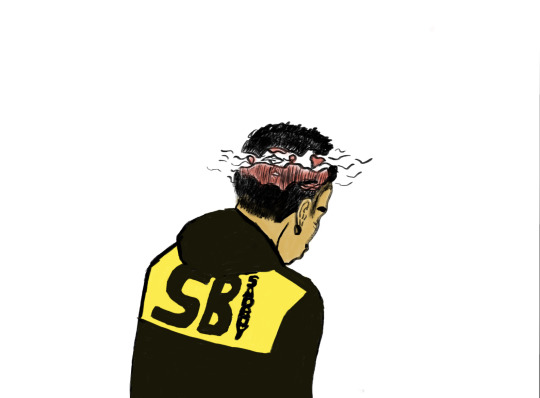
Framing is the presentation of visual elements in an image about other objects. Indeed, balance is a prized commodity in our culture, and it is no surprise that our implicit, intuitive relationship with it has equipped us to sense balance--or imbalance--in the things we see, hear, smell, taste, and touch.” (p. 49) Framing can make an image more aesthetically pleasing and keep the viewer's eye focused on the framed objects. “A frame can serve to either emphasize or downplay its contents.” (p. 125) In this design, I used the frame to make the perception of the camera looking down. The jacket as well as flying plane is meant to catch the viewers eye first. Jacques Derrida defined framing as a structure that is both present and absent. The frame is subservient to the content it surrounds, disappearing as we focus on the image or object on view. The mechanical eye tends to cut the camera into fields of vision. The point of this frame is to look deeper into the mind of the person in the image. The statement is that the person is at a higher level of thinking, his mind is open. This frame created a condition for better understanding of the image.
Transparency
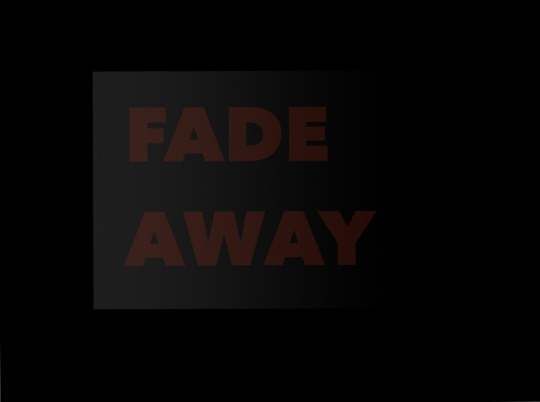
In design, transparency can be defined as something that is nearly or completely invisible. Words, pictures, and textures can all become transparent. Lupe suggests that “…transparency suggests clarity and directness.” Yet in design, transparency is often used to create dense, layered imagery built from color and texture. In this design I used a brand name I’ve been experimenting with called “fade away”. Fade away represents the fading of the mind from the world in order to elevate and become closer with the universe. “Transparency means a simultaneous perception of different spatial locations. . . . The position of the transparent figures has equivocal meaning as one sees each figure now as the closer, now as the farther one” Gyorgy Kepes”. (Lupton 451) Transparency is often used not for the purposes of clarity, but to create dense, layered imagery built from veils of color and textures. I lowered the opacity to 17 and added red lettering to a black background to make the words stand out.
Diagram

This diagram design was inspired by anime styled drawing in a series called “Monster’’. A diagram is a simplified drawing showing the appearance, structure, or workings of a design in a schematic structure. “Diagrams allow us to see relationships that would not come forward in a straight list of numbers or a verbal description.” (Lupton 215) This diagram has both words and pictures laying out more background information. The words directly respond to the image falling under the category of either good or bad. I wanted to explore the visual aspect of the words “good” and “bad”. I used angel to represent good and devil to represent bad. Though a simple style the message was still able to be understood. The overarching message of the image was that love is above all. In all images love has been presented in some way or form. Diagrams add a layer of detail to a design that can make it look more professional.
Grid

(8) Grid. In graphic design, a grid is a structure made up of intersecting straight or curved lines used to structure content. Grids are tools for organizing space, text, images, and other elements placed in a design. Grids add structure to a design. They lead to rational standardized systems that help people absorb the information trying to be communicated. The grid serves as an framework on which a designer can organize graphic elements in a rational manner. Grids allow designers to add elements to a layout while using the grid structure. In this design, I wanted the theme to be digital so I used colors like deep blue, red, and yellow. The Grid also gives this design a digital feel with horizontal, vertical, curved, and straight lines. The lines give depth to the image but also gives the image a 3D effect.
Motion

Motion is one of the most exciting aspects in graphic design. “Motion is a kind of change, and change takes place in time. Motion can be implied as well as literal…” (Lupton 233) Motion in graphic design is often used in the film industry with Openings to movies, television shows, and news programs can use photography to make the introduction. In this design I used motion to show the process of a seed growing. Before the seed grew, it rained, the sun came out, and once the seed finished growing a flower bloomed. This process is not easy it involves patience and time. Motion graphics are pieces of animation or digital footage that create an illusion of motion or rotation. Animation is my favorite form of motion. The design is all hand drawn using the flip book method. The flip book method is basically taking multiple flashcards and combining them by flipping them to create the illusion of motion.
0 notes
Photo
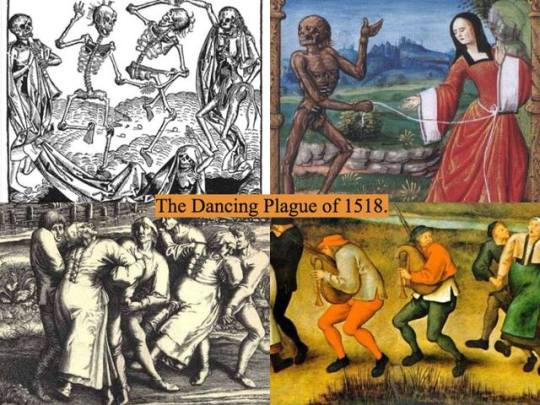
The Dancing Plague of 1518
It was the 14th of July 1518 when Frau Troffea in Strasburg, Alsace left her home and started dancing. She kept doing so for the first day only collapsing from exhaustion briefly. By the third day her feet were drenched in blood and she was carted off to a shrine for St.Vitus in Saverne as the Imlin family’s chronicle notes. Paracelsus recorded how her illness was attributed to this saint due to his representing conditions like the falling sickness or plague.The Dancing Plague is one of the most singular and puzzling medical events of history and even now the reasons for it occurring are wildly debated. The world that Frau Troffea lived in was one in which women could birth monsters, saints and demons could intercede with humanity and magic and religion were central ways of understanding the world.A killer dance must be understood in light of this.
Soon other people were joining Troffea in the deadly dance. Within four days thirty-four people were infected in total ,the 17th century chronicle of Oseas Schad discusses that this soon jumped to two hundred and within four weeks of Troffea’s dance this number doubled to four hundred as the Imlin family’s chronicle said.
To the citizens it was evident that either the sufferers blood was overheated or spiritual figures like God,the Devil or Saints were involved. The city’s Council of Twenty One argued for the former cause to start with ,prohibiting masses for it at first as in their view it was the Galenistic overheating of blood which was the Cause.And such natural sickness,one chronicler noted,required natural curative means.Galen treatments for it should have involved cooling through cold foods or bleeding yet the actions took by the city’s government did not involve this. Instead more dancing was prescribed…
The Council of Twenty-One ordered two town guidhalls to be set aside for dancers and employed guards to watch over the sufferers as they danced. Daniel Specklin noted that people danced with the victims by the sound of fife and drum with chronicler Hieronymus Gebwiler noting “they dance day and night with those poor people”. It didn’t work.
And thus people turned to spiritual means. Gebwiler ,a Alsation Humanist argued that the Strasbourgeois had been punished by God for forgetting Christ’s suffering for them and stated that the glee of people watching one woman who danced for six day led to her passing it on through being watched. Even dancing in and of itself was a cause for the curse as the citizens had danced shamefully ,in blasphemous fashion and with the wrong people or in the wrong places. This act of rhythmic movement that seems so neutral to us today was symbolically powerful enough to cause those like Calvin to ban it gradually everywhere in Geneva between 1539-49.
To combat it, documents by Sebastian Brant in the Munincipal Archive of Strasbourg preserve accounts of how on august 3rd dancing was banned with a fine on it of 30 shillings til St Micheals in September 29th.Only stringed insturments could be used in Masses or at Weddings as it was believed that drums and tambourines could make the condition worse and on top of these things Loose persons like prostitutes and gamblers(Leichtfertigen) were banished and a hundred pound candle was bought for a high mass and three low masses. They then turned to St.Vitus.A child maytr ,saint and holy helper representing a disease he was prayed to for conditions like epilepsy and as the crisis deepened the new dancing disease or plague. Consequently were put in carts and took away to the Saverne St Vitus shrine where they were prayed over by the priests and given pfennigs to offer to the church. Specklin notes how they fell down at images of St. Vitus , were given little crosses and red shoes with the sign of the cross on them and were blessed with holy water. Many seemed to recover. By August and September the plague started by one lone woman’s dance drew to a close , but not without many horrific deaths occurring as people moved continuously until their bodies could not take it anymore.
The medieval period was filled with cases of similar dancing themed mass delusions or illnesses. In 1247 the children of the Germanic town Erfurt danced with some dying, 200 people in Maastricht during 1278 did likewise while the summer of 1374 Rhineland provinces to Aachen, Ghent, Metz and Strasbourg danced and had delusions of a devil called Friskes making them do it ,1375 saw it in France and Holand, 1381 an outbreak of dancing occurred in Augsburg, 1428 saw it occur in Zurich and the cloisters of St. Agnes in Schaffhausen where monks danced until they died.
The mass of dancing plagues like this before and after the 1518 outbreak was therefore substantial…It’s just the 1518 version captured the public imagination and crystalized people’s reactions to it in an ever larger Renaissance world of disseminated news and knowledge. The surprisingly fact that many of the outbreaks between the 14th century and 1518 outbreak happened along the Rhine and Mosel rivers begs thinking about. Why was this area so damaged by the dancing phenomena? What causes do we now attribute to it?
Modern explanations for the event are as varied as contemporary ones. It has been argued that the condition is evidently psycho-physical as touch or contact isn’t needed to pass it on. It could not have been a wholly somatic condition but something else. The explanation used for such dancing symptoms in Italy was Tarantism. This was a dancing condition caused supposedly by the bite of a local spider in the Apulian region of Italy as deforestation during the 1400s-1600s had caused them to spread. However, their venom even when combined with the heat of the area is unlikely to have produced proper dancing. Ergot poisoning is another suggestion. Eugene Backman claims that the mold of ergot formed on damp rye stalks which would have been cultivated in the area of Strasbourg. The problem with this reasoning is that everyone should have been affected if it was throughout all the rye being eaten. Also it causes delusions, yes, but also gangrene which none of the sufferers are described as having in the records and dancing over fits is not a symptom of ergot.
John C. Waller suggests a combination of factors,both physical and psychic. It could not be a heretical cult as some historians claim as the sufferers begged for help and the church never saw them as heretics.Instead the degredation and chaos of Renassiance life in Strasbourg likely had a mental and physical impact on people. Serious famines had occurred in 1492,1502,1511 while drought occurred in summer 1516.1517 was deemed the bad year by one resident.With agricultural and thus monetary and food uncertainties many families took out high interest loans,slaughtered their livestock and begged for charity in Strasbourg. A bad pox had arrived in 1495 and syphilis was introduced by mercenary pike men returning from the Italian wars in 1517. August of that year saw many attending a holy procession ‘contra pestilentiam’ and begging the virgin,st Sebastian and s troche for mercy. The English sweating sickness arrived in Strasbourg by 1517 killing people in a mix of copious sweating,delirium and unquenchable thirst.All of this,as Waller shows, represents the fact that during the year 1518 a number of phenomena came together to make this astounding event possible..The people of Strasbourg had been beaten down for decades by circumstances out of their control which affected their health and impacted the way they approached the world mentally.
As works on the subjective experience of psychosis across different cultures has shown, like Luhrmann et al’s paper, just location and the resulting specific culture of a place can greatly impact one’s experience of auditory hallucinations and other symptoms. In places like Ghana voices have been found to be more positive and accepted by the person with them than places like the USA where they are more negative. The world of 1518 Strasbourg was one of gods and demons, plagues and monsters, heaven and hell…Whether the condition that prompted the dancing in this case or others was physical, mental or both is still unclear, but nevertheless it was something that could happen and did. Four hundred people of the city of Strasbourg took to their feet and moved until dead or bloody. Anything was possible in the Renaissance world they lived in and sometimes you just have to dance.
References:
H.C. Erik Midelfort, A History of Madness in Sixteenth-century Germany, (California: Stanford University Press, 1999), p.32-37
Louis Backman, Religious Dances in the Christian Church and in Popular Medicine, trans. E Classen, (London, 1951), p. 190-234; 22
Die Strasburger Chronik des Elsassischen Humanisten Hieronymus Gebwiler, ed. Karl Stenzel, (Berlin, 1926),p.74-75
Fragments des Anciennes Chroniques d'Alsace, ed. L Dacheux, Vol 4, (Strasbourg, 1901),p.252,
L. Dacheux, Les Chroniques trasbourgeoises de Jacques Trausch et de Jean Wencker. Les annales de Sebastien Brant. Fragments recueillis par l'abbe L. Dacheux(Strasbourg 1892),p.148
Archive Municipal, Strasbourg, R3, fol. 72 recto
John Witte and Robert M Kingdon, Sex, Marriage, and Family in John Calvin’s Geneva: Courtship, Engagement and Marriage ,vol 1,(Michigan and Cambridge: William b.Eerdmans Publishing Company, 2005),p.454,
Les Sources du droit du canton de Geneve, ed. Emile Rivoire and Victor van Berchem,4 vols(Aarau,1927-1935)
John Waller,A Time to Dance, a Time to Die: The Extraordinary Story of the Dancing Plague of 1518, (UK:Icon,2008),p.1-4,6,8-10,83,109, 111-113
LJ Donaldson , J Cavanagh and J Rankin, “The Dancing Plague: a Public Health Conundrum”, The Society of Public Health ,111,(1997),pp.201-204,p.201-203
John Waller, “In a spin: the mysterious dancing epidemic of 1518”, Endeavour, 34,3(2008), pp.117-121
J. F. C Hecker and B. G Babington, The Dancing Mania Of The Middle Ages (Honolulu, Hawaii: University Press of the Pacific, 2004),p.87,104,110
Cancellieri, Francesco, Letters of Francesco Cancellieri to the ch. Signore Dottore Koreff, Professor of Medicine of the University of Berlin, about Tarantism, the airs of Roma, and of its countryside, and the Papal palaces inside, and outside, Rome: with the description of the Pontifical Castel Gandolfo, and surrounding countryside, (Rome: Presso Francesco Bourlie,1817)
JF Russell “Tarantism”, Med Hist, 23,4, (October 1979), pp. 404–25.
9 notes
·
View notes
Text
The history of how these once dense forests moved from abundance to scarcity can be traced through the development of Caribbean literatures. From a very early stage [...] of the region’s literature, its writers have explored the relationship between colonialism and the environment [...]. In the work of these writers, the fate of the Caribbean forests [...] is inextricably linked to colonialism and its metaphors. [...] As the first century of the European conquest progressed, wood was used in large quantities for [...] construction [...] [and] planting of provisions [...]. By far the greatest damage to the forests, however, was done by the development of the plantation [...]. By [1650-1665], descriptions of the Caribbean had shifted from broad depictions of the islands as generic paradise [...], underscoring [...] a Creole consciousness that begins to assess colonial policies in terms of how they use or abuse the colony’s environment. Such is the case of the 1647 “Descripción de la Isla de Puerto Rico,” a proto-literary text by [...] Diego de Torres Vargas, a native of the island [who] express[ed] in writing his [...] pride in [...] the density of its forest. [...]
[Musician trees of Haiti, fanfare of the forest]
Moreau de Saint-Mery’s observations on the state of the forests of Hispaniola are of particular interest here because of the backdrop they offer to one of the most salient literary traditions in Haiti -- that of the celebration of the beauty and extension of the island’s deep forests, which becomes an essential element in the development of the national literature following the revolution. It is a thematic strand that emerges in Haitian poetry from the earliest literary efforts in the nineteenth century and includes a rich vein of poetry on the topic of Haiti’s “musician trees.” Alcibiade Fleury-Battier, in his Sous Les Bambous: Poesies (1881), writes of how he “love[s] the deep forests quivering with the songs / of those winged bards we mistook for flowers” (32) and celebrates Haiti’s centuries-old mapous , sacred trees of Haitian Vodou, in a poem in French that includes lines in Haitian Creole. [...] Likewise, Massillon Coicou [...] writes in the poem “Vents et Flots” about Haiti’s musical trees: “his path / vibrates, in endless hymns, the wild music / of the trees, of the birds, of all the voices / that make up the dazzling fanfare of the forest” (Coicou 95). This love for the forests and delight in the coolness of its groves and musical quality of their presence stands in dramatic contrast to the rapid disappearance of the trees that Haitian novelists like Jacques Roumain or Marie Chauvet will mourn in the twentieth century. [...]
[Loss of mountain forests of Hispaniola during ascent of sugar plantations]
This potential devastation was also evident, as far as the Caribbean region itself was concerned, in the writings of Martinican historian Mederic Louis Elie Moreau de Saint-Mery in his two books on Hispaniola [...] published in 1796. Moreau de Saint-Mery’s texts offer the most comprehensive account of the impact of the intensification of sugar production on a Caribbean island in the eighteenth century. His text chronicles the impact of deforestation on threatened or vanishing species and is particularly eloquent on the nature and fate of the forests of Hispaniola, noting not only their beauty and “inexhaustible fecundity” but also the forces that threaten their very inexhaustibility. “Their utility is proved by continual experience, though their distance from the places where they might be advantageously employed, is often the cause of their remaining in tranquility” (31). Moreover, he explicitly notes the environmental impact of the island’s too-rapid deforestation, especially on the intensification of soil erosion and the reduction in rain levels. In Haiti, the French colonists “who have aided these depredations by the cultivation of coffee, and by a system which counts the time to come as nothing,” he writes, “have cut down even the trees that covered the summits of the mountains and attracted the rains, insomuch that a diminution of the rains is now perceivable in the French part, where they were formerly very considerable and regular”. [...]
[Recent deforestation of Puerto Rico]
Haitian concerns over the damages of deforestation are echoed, for example, in the [...] poetry of noted Puerto Rican poet Juan Antonio Corretjer (1908–85), known for his celebration of the richness and diversity of Puerto Rico’s mountain ecology and its history of subsistence agriculture. Corretjer wrote of his delight at entering “the moist fields with their crisp grassy greenness / through which the river traces its sinuous geometry” (“Pared de la soledad”) and of penetrating forest groves where he could rub against the bark of the trees and “inhale the sacred smoke / that makes the mouth capable of prophecy” (“Yerba bruja”). His environmental activism -- which evolved in the 1950s, predating by some years the similar concerns expressed by Rachel Carson in Silent Spring (1962) -- aimed at counterbalancing the violence that had been perpetrated on the environment by American agricultural corporations, had focused on the impact of agribusiness on the island’s interior. In essays, poems, and interviews he decried “the overwhelming encroachment of concrete and the use of poisonous chemicals [insecticides and synthetic fertilizers] in Puerto Rican farming” that had led not only to massive deforestation in the interior, but also to the disappearance of bird, lizard, and butterfly species that had been plentiful in the landscape of his youth and young adulthood.
--
Text by: Lizabeth Paravisini-Gebert. “Deforestation and the Yearning for Lost Landscapes in Caribbean Literatures.” Postcolonial Ecologies: Literatures of the Environment. 2011. [Bold emphasis, some paragraph breaks/contractions, and italicized bracketed subheadings added by me.]
49 notes
·
View notes
Text
Thoughts on the starting order
Good (very early) morning, folks! It's 5 am and I'm still up because my adrenaline levels haven't dropped since the start of the semi-final. The end of Eurovision season is in sight and I'm as excited as I am apprehensive.
Those of you who've followed this blog for a while will know that I'm an ardent opponent of the producer-created running order - here's an archive of posts just from ESC '16 and '17 where I explain why it is inherently unfair (the long and short of it: it gives advantageous and disadvantageous positions to songs, which goes against the spirit of the competition) and how the producers choosing the running order often fall on the same tropes - using semi-final results to determine where to place the qualified songs.
As outlined in this post, there are positions in the running order that the producers consider much stronger than others, into which they tend to stuff the high-flying semi-finalists and Big 6s that they think will do well - like the 16th act before the end of the show, which is usually 11th place (but was 12th in 2015 on account of there being 27 finalists).
This prime position, almost as close to the end of 1st half as you can be, has only been occupied by a semi-finalist once in the previous four ESCs since random draw was abolished: 11th has been home to Cascada, who were tipped for a good position pre-ESC; Conchita, who won her semi and the whole shebang; Guy Sebastian, making Australia's much hyped début, and Amir, a huge pre-contest favourite. This is where Salvador Sobral has been placed - which makes me feel that he must have done as well as it seemed he did at winning over the fans.
The other strongest positions in the first half are 9th and 13th (10th and 14th in 2015). 18thj from last is where Gianluca (4th in his semi, 8th overall), Maans (winner of both semi and final) and local boy and 5th place in the final Frans were placed - this is where Francesco Gabbani has been slotted. A strong position, but not as good as Salvador's. 14 songs before the end (usually 13th place, 14th place in 2015), the last stop before the second half, is where Dami Im, Sanna NIelsen and Anouk have all performed - a semi final winner, a runner up and 6th place in the semi and 9th in the final respectively. This prime spot, surprisingly, is where Jacques Houdek has been placed. Will he emulate this high-flying female trio or the only blokes to have been assigned this position, the Makemakes with their unfortunate nul points?
Whilst the producers can help you, they can also hinder you. 2nd from the beginning is the dreaded death spot from which no one has ever won - but in recent years, 2nd from last is more of a death sentence. A slot for 3 last place marginal qualifiers from the semis (Georgia '13, San Marino '14, Albania '15) and an unfancied Big 6 (UK last year) seems a very odd place indeed in which to put such a bookies' favourite as Bulgaria. Its juxtaposition is unfavourable too, sandwiched between other favourites in Sweden and France - did it really underwhelm so much to warrant this, or are they actively trying to kill the kid's chances? After the "eventfulness" of this year, could they be afraid of a début Eastern host country taking the reins?
In other news, JOWST seems a surefire marginal qualifier, slotting into 10th position from end (17th, 18th in 2015) which has been home to two countries who qualified in 8th place (Poland 2015 and Hungary 2013) and two in 10th place (Croatia last year and Slovenia in 2014). Out of the quartet, only ByeAlex managed to surpass the mediocre semi final placement with a good finish in the final. It also seems that the city lights are dimming for Blanche, placed fourth from last (usually 23rd, 24th in 2015). It's not been a bad slot for Big 6 allotted it - Basim and Marco Megnoni - but when a semi qualifier has been given fourth from close, they placed 10th and 9th in their semi respectively. Both were Georgians, curiously - Nina and Nika & the Young Georgian Lolitaz.
On the "winners" side, we should also give a mention to Sweden (who perform 3rd from last, like Margaret Berger, the Common Linnets, and Polina) and the UK, who get given 9th from end (usually 18th, 19th in 2015) starting position of a third place semifinalist (Softengine), a semi final runner up (Aminata) and two semi-final winners (Emmelie deForest and Sergey Lazarev). On the "losers" side, their starting positions suggest that Austria, Greece, Poland and Australia scraped through.
29 notes
·
View notes
Video
vimeo
Tant de Forêts - trailer
#Vimeo#forest#prevert#jacques#3d#animation#illustration#paper#deforestation#nature#trailer#tantdeforets
0 notes
Text
This slideshow requires JavaScript.
Press Update:
SELECTED short films focusing on environment and climate change, issues that concern the Philippines, the European Union and the world will be screened in EuroPelikula, one of Allied Festival partners of Cinemalaya, now ongoing in the Cinemalaya Philippine Independent Film Festival until August 16, 2020.
The films are offered for free on the Vimeo platform.
A film festival presented by the European Union, EuroPelikula is screening A SUNNY DAY by Moroccan director Faouzi Bensaïdi, HUNGRY SEAGULL by Chinese director Leon Wang, OLMO by Italian director Silvio Soldini, TUÃ INGUGU by Brazilian director Daniela Thomas, KOKOTA: THE ISLET OF HOPE by Craig Norris, QURUT by Shahrbanoo Sadat, IN ONE DRAG by Alireza Hashempour and TANT DE FORETS by Burku Sankur and Geoffrey Godet.
A Sunny Day is a short film on how men and women survive under the impact of a changing climate, in a distant and near future, both fantastic and absurd. It follows the daily life of a man navigating the devastating effects of climate change on humans and nature.
Hungry Seagull focuses on the lives of a family of seagulls living on an island not far from the mainland, and how they survive amidst the threat of offshore overfishing and the pollution of the marine environment.
Olmo tells about an eighty-year-old grandfather, and his grandson Giulio who read an article from a newspaper about melting glaciers, the greenhouse effect, methane and CO2. Instead of going to school, the two go on an adventure looking for an old tree.
Tuã Ingugu captures the relationship between the Xingu community and their river, and the emotions of one of them when he is taken to see Sao Paulo rivers. It is a poetic movie to denounce water pollution and the challenging prospects for the future of both indigenous people and city folks.
Kokota: The Islet of Hope tells about a man who visits a tiny neighboring islet called Kokota, and tries to help after seeing the island teeter towards a collapse due to climate change and deforestation.
Qurut is about a woman who cooks Quruti, one of the most popular meals in the entire Afghanistan, especially in central Afghanistan. For some years people have been making less and less Quruti as they struggle to feed their animals because the mountain pastures have dried up.
In One Drag tells the story of a man who leaves a building late in the evening to light a cigarette and smoke it in one drag. He casually flicks the stub away, and then all the cigarette butts in the city become alive.
Tant de Forets is a short film based on a poem of Jacques Prévert. The poem speaks of the irony of the fact that newspapers warn us about deforestation although they are made of paper themselves.
The EU signed a cooperation agreement with CCP this year, which immediately was translated to EuroPelikula, a platform to feature films from Europe at the CCP, but was unfortunately stopped due to the pandemic.
Mr. Thomas Wiersing, Chargé d’ affaires of the EU Delegation to the Philippines greatly appreciates the support of Cinemalaya Foundation and the CCP for always putting the film sector among their priorities to reach out to the Filipino audiences. “Europe likewise puts great importance in the film sector as this has become an integral part of its culture,” according to Wiersing. “Clearly film is a shared value which is treasured by both the Philippines and the European Union.”
The Allied Festival section of the Cinemalaya Festival features selected shorts from international film programs, held in collaboration with the Japan Foundation, European Union, the Embassy of the Islamic Republic of Iran, and the Embassy of Mexico.
From The Japan Foundation’s Eiga Sai Film Festival, the films MY LITTLE GOAT by director Misato Tomoki, and A JAPANESE BOY WHO DRAWS by director Kawajiri Masanao will be screened.
From Iran, the film I AM AMERICAN by director Omid Mirzaei will be featured.
From Mexico, the film BRUMA by writer and director Max Zunino will be shown.
In view of the COVID-19 situation, the 16th edition of Cinemalaya migrates to the online platform Vimeo. Cinemalaya Philippine Independent Film Festival is a project of the Cultural Center of the Philippines and the Cinemalaya Foundation, Inc. Established in 2005, Cinemalaya is an all-digital film festival and competition that aims to discover, encourage and honor cinematic works of Filipino filmmakers.
For details, visit www.cinemalaya.org or www.culturalcenter.gov.ph, or contact the CCP Media Arts at 8832-1125 local 1704 to 1705 and the CCP Box Office at 8832-3704. Check out the official CCP and Cinemalaya Facebook and Instagram accounts.
Environment and Climate Change among themes for Cinemalaya 2020 EuroPelikula Short Films Press Update: SELECTED short films focusing on environment and climate change, issues that concern the Philippines, the European Union and the world will be screened in EuroPelikula, one of Allied Festival partners of Cinemalaya, now ongoing in the Cinemalaya Philippine Independent Film Festival until August 16, 2020.
0 notes
Text
https://youtu.be/A5dBBJhgGvs
youtube
27th May >> (@RomeReports) #Pope Francis #PopeFrancis meets Raoni, tribal leader of the indigenous Kayapó people.
Pope Francis met with one of the most active Amazonian leaders. Raoni Metuktire, leader of the Kayapó people, came to the Vatican with his son.
POPE FRANCIS
"It's a pleasure, a pleasure to greet you and to receive you".
The pope wanted to exchange points of view with Raoni and lay groundwork for the upcoming October Amazon Synod.
“Here is the entire Amazon. Here is the town of Raoni. It is here; it is here, and the village of Tapí.”
“Here you can see the deforestation. All of this. The zone that is still healthy is the one they protect.”
As a gift, the indigenous leader gave Pope Francis his biography. The pope in return gave him some medals and documents relating to his pontificate.
Pope Francis affectionately bid him farewell.
"Take care."
He also hugged him.
For decades, Raoni has been traveling all over the world to raise awareness about the danger of deforestation in the Amazon.
Throughout all of this campaigning, he has been supported by former French president Jacques Chirac and musician “Sting”.
0 notes